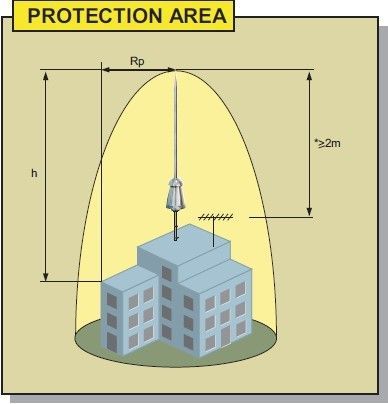Nimbus CPT lightning rod - ESE technology

Product Name:Nimbus CPT lightning rod - ESE technology
Product Model:nimbus CPT-1,nimbus CPT-2,nimbus CPT-3
Updated:2010.03.29
Views:2

CPT NIMBUS
Nimbus CPT lightning rod - ESE technology
Active protection. CPT NIMBUS lightning rods with ESE (Early Streamer Emission) technology are designed and manufactured according to state-of-the art technology in AISI 316 stainless steel. The impact of the lightning strike takes places at a point above the tip of the rod thanks to the ESE technology. This means a larger radius of protection and it enhances the cost efficiency of the lightning protection system (LPS) as compared to passive systems.Selection of nimbus model
It is necessary to know the protection radius (Rp) and the protection level (NP) in order to do the selection of
an external protection accordingly..
LEVEL OF PROTECTION
The protection level is a parameter to be determined according to the established standard. We use UNE
21186-96 based on NF C 17-102 standard. These standards establish three protection levels.
The protection level depends on:
· Lightning strikes density in the area.
· Situation of the structure to be protected (urban or rural zone, high buildings near the installation, …)
· Type of structure.
· Buildings location.
· Cost valuation of period of the installation due to damages because of the lightning strikes.
Sometimes this last item is the cause of selecting a protection level I (Maximum security), as the losses
because of non-operation the installation could be important.
RADIUS OF PROTECTION
For the correct selection of (ESE)rod in the external protection of a structure or building it is very important to know another parameter: the protection radius (Rp).
The protection radius is the distance between the point where you want to place the (ESE) rod and the further point from the structure or building we want to protect.
NP: Protection Level
Rp: Protection Radius
H: Height of the top of the Nimbus
on the surface to be protected.
Example of selection of nimbus model
Once we have the preliminary parameters (NO and Rp), we could select the most suitable ESE. For having a correct protection, the top of the ESE has to be 2 m minimum above any other point of the structure.
Example situation: NP: I, Rp: 50 m.
The ESE selection is done since its features board, by determining model and which height it should
be situated.
| Model | Level Ⅰ | Level Ⅱ | Level Ⅲ | ||||||
| RP set up a high degree of protection of radius h | Nimbus CPT-1 | Nimbus CPT-2 | Nimbus CPT-3 | Nimbus CPT-1 | Nimbus CPT-2 | Nimbus CPT-3 | Nimbus CPT-1 | Nimbus CPT-2 | Nimbus CPT-3 |
| 2 | 17 | 24 | 32 | 23 | 30 | 40 | 26 | 33 | 44 |
| 3 | 25 | 35 | 48 | 34 | 45 | 59 | 39 | 50 | 65 |
| 4 | 34 | 46 | 64 | 46 | 60 | 78 | 52 | 67 | 87 |
| 5 | 42 | 58 | 79 | 57 | 75 | 97 | 65 | 84 | 107 |
| 6 | 43 | 58 | 79 | 58 | 76 | 97 | 66 | 84 | 107 |
| 8 | 43 | 59 | 79 | 59 | 77 | 98 | 67 | 85 | 108 |
| 10 | 44 | 59 | 79 | 61 | 77 | 99 | 69 | 87 | 109 |
| 15 | 45 | 59 | 80 | 63 | 79 | 101 | 72 | 89 | 111 |
| 20 | 45 | 60 | 80 | 65 | 81 | 102 | 75 | 92 | 113 |
| 45 | 45 | 60 | 80 | 70 | 85 | 105 | 84 | 98 | 119 |
| 60 | 45 | 60 | 80 | 70 | 85 | 105 | 85 | 100 | 120 |
| Start pre-empt the time △ T (μS) | 27µS | 44µS | 60µS | △ T: According to NFC17-102 required to start pre-empt the time. The actual test value greater than the specified value | |||||
1- Selection in protection level I, the Rp equal or immediately upper rating(58 m).
2- The vertical index indicates the model to be installed (nimbus CPT-2).
3- The horizontal index indicates the minimum height (h) of (nimbus in this case, minimum 5 m).
Protection of radius calculated as follows:
According to NFC17-102 test standard, are given protection through laboratory radius formula:

Of which:
Rp: radius of lightning protection
h: the installation of lightning rod height (lightning rod tip to the protected object plane height, mounting height as low as 2M)
D: To be protected from electric shock buildings, according to laboratory derived:
I kind of buildings from the shock: D = 20M
Class II buildings from the shock: D = 45M
Class III electric shocks from the building: D = 60M
△ T: Laboratory Evaluation of the first to arrive at boot time, see Table
△ L: E-discharge system from the upstream pre-empt the
△ L = V (m / μS) X △ T (μS)
V: as the forerunner speed V = 1.00m/μS
